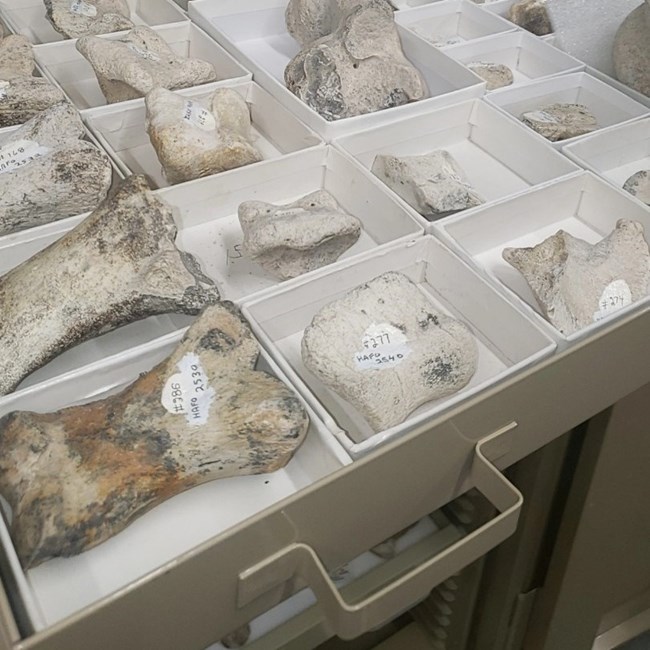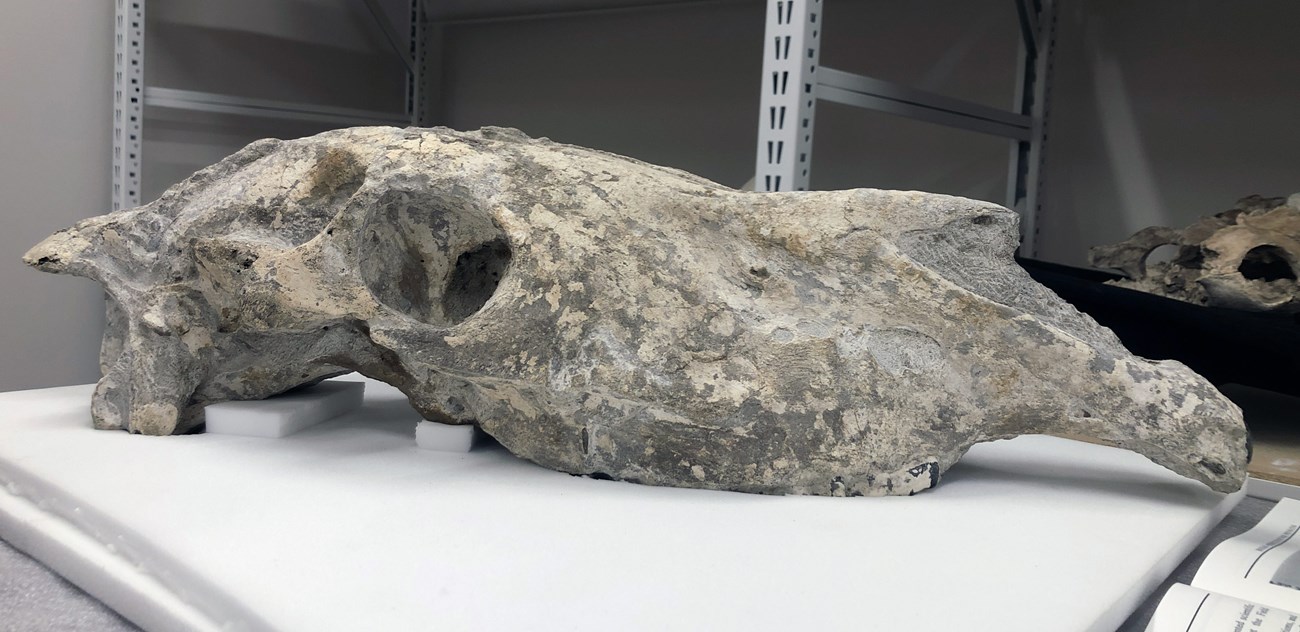Last updated: June 13, 2024
Article
Radioactive Horses and Hot Weasels: Solving an Age-Old Problem at Hagerman Fossil Beds with Science
Written by Karina Rapp
What do you do when your famous Pliocene paleontology collection creates a hazardous work environment?
This has been a problem faced by the Hagerman Fossil Beds National Monument ever since its founding in 1988. Due to the unique geology of the region, combined with the natural process of fossil formation, excessive amounts of uranium were captured in Hagerman’s fossils while they were forming. Radon is a radioactive, colorless, and odorless gas produced by decaying uranium. Some fossils are more radioactive than others due to different depositional environments. Although the radioactive nature of Hagerman’s fossils has been studied in detail, radon has remained a well-known problem for staff curating the monument’s national collection. Offices and storage rooms would regularly contain levels of radon which exceeded the Environmental Protection Agency’s limit of 4 picocuries per liter of air (pCi/L). Excessive amounts can cause serious health problems such as lung cancer. Recommendations were made to reduce exposure, but no permanent solution was achieved.
When the collections were moved into a new building in 2021, this proved to be a perfect opportunity to study the issue and create a safer working and storage environment.
What do you do when your famous Pliocene paleontology collection creates a hazardous work environment?
This has been a problem faced by the Hagerman Fossil Beds National Monument ever since its founding in 1988. Due to the unique geology of the region, combined with the natural process of fossil formation, excessive amounts of uranium were captured in Hagerman’s fossils while they were forming. Radon is a radioactive, colorless, and odorless gas produced by decaying uranium. Some fossils are more radioactive than others due to different depositional environments. Although the radioactive nature of Hagerman’s fossils has been studied in detail, radon has remained a well-known problem for staff curating the monument’s national collection. Offices and storage rooms would regularly contain levels of radon which exceeded the Environmental Protection Agency’s limit of 4 picocuries per liter of air (pCi/L). Excessive amounts can cause serious health problems such as lung cancer. Recommendations were made to reduce exposure, but no permanent solution was achieved.
When the collections were moved into a new building in 2021, this proved to be a perfect opportunity to study the issue and create a safer working and storage environment.

NPS Photo/Alex Kim
How Was a Safer Fossil Storage Solution Found?
State-of-the-art technology utilizing Wi-Fi, Bluetooth, and iPad apps was used to collect hourly radon levels for the new paleontology building and its fossil storage cabinets. Since radon gas is made less dangerous by diluting it with fresh air, several experiments were run between August to December 2022 to determine the most efficient way to accomplish this.Over thirty days’ worth of data was collected for each room in the building and for individual cabinets. Ventilation was the primary focus: comparing no added airflow, to partial air replacement, to total air replacement. While the concept was not a new one, this was the first time that comprehensive data had been collected for the new building to standardize monitoring and permanently improve working conditions.
What Were the Results?
Total air replacement created the safest environment and was accomplished by running the HVAC system’s fan 24/7. It was the quickest method and resulted in daily averages well below the EPA limit. However, it would be expensive to run and maintain long-term, so another solution was found. Energy Recovery Ventilation (ERV) systems are used by other museums, such as the Arizona Museum of Natural History, to improve air quality and reduce exposure to radon.Based on the data, analysis, and results of this study, upper management approved funding to develop designs for an ERV system. Collected data has helped the engineers create the most ideal solution for the Hagerman Fossil Bed’s specific needs. Design proposals have recommended various solutions that will greatly reduce costs and increase the speed of air replacement, making collection access safer for staff and researchers.
Small solutions such as keeping temperature and humidity within certain ranges, storing small fossils in airtight containers, and organizing cabinets by taxonomic family (placing hot horses in their very own aisle, for example) have also contributed to a healthier work environment. New standard operating procedures have been written for the collection, and weekly monitoring activities continue.

NPS Photo/Karina Rapp
When Can Data Save the Day for “Rad” Museums?
Long-term scientific data can be used to justify building alterations and specialized construction for the housing of radioactive fossils and other hazardous museum objects. Data can also be used to inform management decisions and create standards for storing such collections. Monitoring equipment, specialized mitigation systems, museum environment controls, and simple storage solutions can all improve safety and accessibility for staff and the public, reduce costs, and help museums do more with less.An in-depth technical paper will be released later in 2024.
Special thanks to Gavin McCullough (Collections Manager) for providing a tour of the Arizona Museum of Natural History’s paleontology mitigation system.

